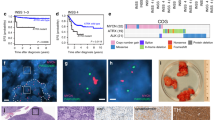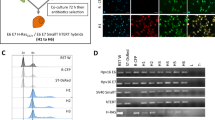Abstract
A variant t(1;19)(q23;p13.3) translocation creates reciprocal DAZAP1/MEF2D and MEF2D/DAZAP1 fusion genes that are expressed in acute lymphoblastic leukemia. We used retroviral gene transfer to ectopically express wild-type and chimeric DAZAP1 and MEF2D fusion proteins in NIH 3T3 cells. In soft agar assays, each of the fusion proteins transformed 3T3 cells with a 20-fold increase in colony formation as compared to empty vector or native MEF2D or DAZAP1 proteins. Co-expression of both DAZAP1/MEF2D and MEF2D/DAZAP1 led to a threefold increase in colony formation as compared to either fusion protein alone. Expression of wild-type DAZAP1, MEF2D or DAZAP1/MEF2D allowed 3T3 cells to proliferate under low serum (0.5%) conditions and suppressed apoptosis. In contrast, MEF2D/DAZAP1 expression did not facilitate proliferation in low serum and led to a modest increase in apoptosis. Both MEF2D/DAZAP1 and DAZAP1/MEF2D have oncogenic properties, and co-expression of both fusion proteins is synergistic.
This is a preview of subscription content, access via your institution
Access options
Subscribe to this journal
Receive 12 print issues and online access
$259.00 per year
only $21.58 per issue
Buy this article
- Purchase on Springer Link
- Instant access to full article PDF
Prices may be subject to local taxes which are calculated during checkout




Similar content being viewed by others
References
Rego EM, Pandolfi PP . Reciprocal products of chromosomal translocations in human cancer pathogenesis: key players or innocent bystanders? Trends Mol Med 2002; 8: 396–405.
Alcalay M, Zangrilli D, Fagioli M, Pandolfi PP, Mencarelli A, Lo Coco F et al. Expression pattern of the RAR alpha-PML fusion gene in acute promyelocytic leukemia. Proc Natl Acad Sci USA 1992; 89: 4840–4844.
Grimwade D, Biondi A, Mozziconacci MJ, Hagemeijer A, Berger R, Neat M et al. Characterization of acute promyelocytic leukemia cases lacking the classic t(15;17): results of the European Working Party. Blood 2000; 96: 1297–1308.
Yuki Y, Imoto I, Imaizumi M, Hibi S, Kaneko Y, Amagasa T et al. Identification of a novel fusion gene in a pre-B acute lymphoblastic leukemia with t(1;19)(q23;p13). Cancer Sci 2004; 95: 503–507.
Prima V, Gore L, Caires A, Boomer T, Yoshinari M, Imaizumi M et al. Cloning and functional characterization of MEF2D/DAZAP1 and DAZAP1/MEF2D fusion proteins created by a variant t(1;19)(q23;p13.3) in acute lymphoblastic leukemia. Leukemia 2005; 19: 806–813.
McKinsey TA, Zhang CL, Olson EN . MEF2: a calcium-dependent regulator of cell division, differentiation and death. Trends Biochem Sci 2002; 27: 40–47.
Tsui S, Dai T, Roettger S, Schempp W, Salido EC, Yen PH . Identification of two novel proteins that interact with germ-cell-specific RNA-binding proteins DAZ and DAZL1. Genomics 2000; 65: 266–273.
Pear W, Scott ML, Nolan GP . Generation of high-titer, helper-free retroviruses by transient transfection. In: Robbins P (ed). Methods in Molecular Medicine: Gene Therapy Protocols. Humana Press: Totowa, NJ, 1996; pp 41–58.
Muscat GE, Perry S, Prentice H, Kedes L . The human skeletal alpha-actin gene is regulated by a muscle-specific enhancer that binds three nuclear factors. Gene Expr 1992; 2: 111–126.
Qiu RG, Abo A, McCormick F, Symons M . Cdc42 regulates anchorage-independent growth and is necessary for Ras transformation. Mol Cell Biol 1997; 17: 3449–3458.
Moustakas A, Stournaras C . Regulation of actin organisation by TGF-beta in H-ras-transformed fibroblasts. J Cell Sci 1999; 112 (Part 8): 1169–1179.
DiMartino JF, Ayton PM, Chen EH, Naftzger CC, Young BD, Cleary ML . The AF10 leucine zipper is required for leukemic transformation of myeloid progenitors by MLL-AF10. Blood 2002; 99: 3780–3785.
Fadok VA, Voelker DR, Campbell PA, Cohen JJ, Bratton DL, Henson PM . Exposure of phosphatidylserine on the surface of apoptotic lymphocytes triggers specific recognition and removal by macrophages. J Immunol 1992; 148: 2207–2216.
Suzuki T, Shen H, Akagi K, Morse HC, Malley JD, Naiman DQ et al. New genes involved in cancer identified by retroviral tagging. Nat Genet 2002; 32: 166–174.
Sun L, Youn HD, Loh C, Stolow M, He W, Liu JO . Cabin 1, a negative regulator for calcineurin signaling in T lymphocytes. Immunity 1998; 8: 703–711.
Youn HD, Sun L, Prywes R, Liu JO . Apoptosis of T cells mediated by Ca2+-induced release of the transcription factor MEF2. Science 1999; 286: 790–793.
Youn HD, Chatila TA, Liu JO . Integration of calcineurin and MEF2 signals by the coactivator p300 during T-cell apoptosis. EMBO J 2000; 19: 4323–4331.
Youn HD, Grozinger CM, Liu JO . Calcium regulates transcriptional repression of myocyte enhancer factor 2 by histone deacetylase 4. J Biol Chem 2000; 275: 22563–22567.
Mao Z, Bonni A, Xia F, Nadal-Vicens M, Greenberg ME . Neuronal activity-dependent cell survival mediated by transcription factor MEF2. Science 1999; 286: 785–790.
Shin HH, Seoh JY, Chung HY, Choi SJ, Hahn MJ, Kang JS et al. Requirement of MEF2D in the induced differentiation of HL60 promyeloid cells. Mol Immunol 1999; 36: 1209–1214.
Han TH, Prywes R . Regulatory role of MEF2D in serum induction of the c-jun promoter. Mol Cell Biol 1995; 15: 2907–2915.
Pan F, Ye Z, Cheng L, Liu JO . Myocyte enhancer factor 2 mediates calcium-dependent transcription of the interleukin-2 gene in T lymphocytes: a calcium signaling module that is distinct from but collaborates with the nuclear factor of activated T cells (NFAT). J Biol Chem 2004; 279: 14477–14480.
Rao S, Karray S, Gackstetter ER, Koshland ME . Myocyte enhancer factor-related B-MEF2 is developmentally expressed in B cells and regulates the immunoglobulin J chain promoter. J Biol Chem 1998; 273: 26123–26129.
Wallin JJ, Rinkenberger JL, Rao S, Gackstetter ER, Koshland ME, Zwollo P . B cell-specific activator protein prevents two activator factors from binding to the immunoglobulin J chain promoter until the antigen-driven stages of B cell development. J Biol Chem 1999; 274: 15959–15965.
Satyaraj E, Storb U . Mef2 proteins, required for muscle differentiation, bind an essential site in the Ig lambda enhancer. J Immunol 1998; 161: 4795–4802.
Morton S, Yang HT, Moleleki N, Campbell DG, Cohen P, Rousseau S . Phosphorylation of the ARE-binding protein DAZAP1 by ERK2 induces its dissociation from DAZ. Biochem J 2006; 399: 265–273.
Zhang T, Kruys V, Huez G, Gueydan C . AU-rich element-mediated translational control: complexity and multiple activities of trans-activating factors. Biochem Soc Trans 2002; 30 (Part 6): 952–958.
Perrotti D, Calabretta B . Post-transcriptional mechanisms in BCR/ABL leukemogenesis: role of shuttling RNA-binding proteins. Oncogene 2002; 21: 8577–8583.
Ron D . TLS-CHOP and the role of RNA-binding proteins in oncogenic transformation. Curr Top Microbiol Immunol 1997; 220: 131–142.
Acknowledgements
We thank Drs Brad Fletcher and Kishalay Hoare, University of Florida, for providing the packaging and target cell lines and valuable technical advice. This work was supported by a grant from the Pediatric Cancer Foundation to SPH.
Author information
Authors and Affiliations
Corresponding author
Rights and permissions
About this article
Cite this article
Prima, V., Hunger, S. Cooperative transformation by MEF2D/DAZAP1 and DAZAP1/MEF2D fusion proteins generated by the variant t(1;19) in acute lymphoblastic leukemia. Leukemia 21, 2470–2475 (2007). https://doi.org/10.1038/sj.leu.2404962
Received:
Revised:
Accepted:
Published:
Issue Date:
DOI: https://doi.org/10.1038/sj.leu.2404962
Keywords
This article is cited by
-
DAZAP1 overexpression promotes growth of HCC cell lines: a primary study using CEUS
Clinical and Translational Oncology (2022)
-
Myocyte enhancer factor 2D provides a cross-talk between chronic inflammation and lung cancer
Journal of Translational Medicine (2017)
-
Recurrent DUX4 fusions in B cell acute lymphoblastic leukemia of adolescents and young adults
Nature Genetics (2016)
-
miR-218 suppressed the growth of lung carcinoma by reducing MEF2D expression
Tumor Biology (2016)
-
Myocyte enhancer factor 2D promotes tumorigenicity in malignant glioma cells
Tumor Biology (2016)



